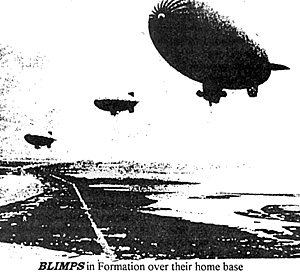 Black Eye for Soldier of Fortune Magazine
Black Eye for Soldier of Fortune Magazine
The June 1980 issue of SOLDIER OF FORTUNE Magazine carried an article entitled ‘WOLF PACK SKIPPER’ written by a man named Marv Wolf and the subject was a fellow named Heinz Houben. Houben claimed, among other things, that he was in the crew of U-134 when this BLIMP was shot down.
BLIMPS in Formation over their home base.
I spoke with him by telephone and asked how he was still alive, since the boat never returned from that patrol. I also asked about many of his other claims, all equally questionable, and he suddenly refused to talk with me any longer. A check of official records was unable to find his name in any capacity in the Kriegsmarine or even in the German military forces at all.
In the article, it is claimed that he served aboard U-134, U-82, U-181 and U-2456. His claim that he was I.W.O. on U-181 when it went to Penang, proved false as OTTO GIESE (45-1984) was II. W. O. on that boat, on that patrol and he never heard of Houben. The easiest claim to de-bunk was that he was Skipper of U-2456, a TYPE XXI boat on patrol in the South Atlantic at the end of the war. There were no TYPE XXI boats on patrol anywhere, let alone the South Atlantic. Further, U-2456 was not a TYPE XXI, but a TYPE XXIII coastal boat that certainly did not have that kind of range. To cap it off, U-2456 was never built! Her building order was canceled when the war ended.
Houben lives on the American west coast and every so often, he tries to join SHARKHUNTERS but for some reason, his application never gets approved.
Here is the official US Navy report on the loss of BLIMP K-74
“On the evening of July 18, 1943, the blimp K-74, on routine night patrol in the Richmond #1 patrol area, was cruising at an altitude of 500 feet. Light from the moon just past full brilliantly on the calm surface of the sea. Shortly before midnight, a blip was picked up on the ship’s Radar. the course was changed in the direction of the bearing, and the crew took their battle stations. Presently, half a mile to port, a submarine was sighted clearly silhouetted in the moonlight in Lat. 23.59’N; Long 80.49’W, course 220 degrees, traveling at a speed of fifteen knots. No sign of life was seen aboard and the blimp circled twice then decided to attack.
Apparently unnoticed, the blimp approached up moon at 47 knots. When within 200 yards the U-Boat opened fire with .50 caliber guns. The blimp returned fire most effectively from her forward .50 caliber gun and held on. The order to release bombs was given, but the bombardier, a new crew member but presumably experienced, operated the release incorrectly and the airship passed over the submarine with the bombs still in their racks. Now both submarine and airship began circling, firing their .50 calibers at the same moment. As she passed over the target the second time, the bombs again failed to release, and as a result the blimp went out of control and rose sharply. Fire from the submarine continued for a few seconds. The blimp lost altitude and settled in the water some distance away. Nothing further was seen of the submarine. On the following day, nine members of the crew were picked up by surface craft. One man was missing - the bombardier, who had apparently become separated from the group, was apparently attacked by a shark, several of which were about the party.
Meanwhile search of the area by surface and aircraft continued and almost exactly twenty four hours later a PV-1 on patrol sighted the wake of a submarine in the moonlight and shortly afterward, the surfaced submarine itself, northeast of Cay Sal Bank, not far from where the encounter of the previous night had taken place. Making a beam attack, the plane dropped a stick of six 350-pound Torpex depth charges. The first fell short. the second struck at the base of the conning tower and was followed shortly after by a huge geyser of water as it exploded. The remaining four were unobserved, as the tail of the plane obscured vision aft when the plane climbed to regain altitude after the attack. When the plane returned to the scene, the submarine had disappeared and while this is not taken as positive evidence of its destruction it is felt that it was badly damaged and quite possibly sunk.
The loss of the blimp, while unfortunate, especially in view of the most regrettable failure to drop bombs whereby the submarine escaped almost certain destruction, nevertheless is partly compensated for by the conclusions which have been drawn from the incident and the specific recommendations which it has been possible to make with a view toward avoiding the recurrence of a similar happening. The value of lighter-than-air craft in anti-submarine warfare still appears to remain unquestioned.
Fate of the BLIMP Commander
The use of a Navy BLIMP was always to detect and deter, not to attack. Once enemy U-Boats were spotted, the BLIMP was to call in the ASW ships and/or aircraft - they were not to attack with the BLIMP.
Lieutenant Grill’s decision to use K-74 as an offensive weapon nearly got him court martialed but later, it won him the DISTINGUISHED FLYING CROSS.
Back to KTB #120 Table of Contents
Back to KTB List of Issues
Back to MagWeb Master Magazine List
© Copyright 1996 by Harry Cooper, Sharkhunters International, Inc.
This article appears in MagWeb (Magazine Web) on the Internet World Wide Web. Other military history articles articles are available at http://www.magweb.com
Join Sharkhunters International, Inc.: PO Box 1539, Hernando, FL 34442, ph: 352-637-2917, fax: 352-637-6289, www.sharkhunters.com
